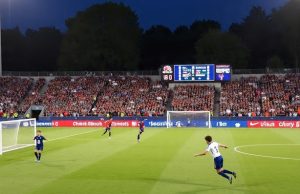How Long is a High School Soccer Game? Learn how long high school soccer games last in the US. Complete guide covering 80-minute game duration, overtime rules, halftime, and what to expect as a parent or spectator.
How Long is a High School Soccer Game?
High school soccer games in the United States typically last 80 minutes of playing time, divided into two 40-minute halves. However, the total time commitment for players, parents, and spectators is usually between 90-120 minutes when including halftime, stoppage time, and potential overtime periods.

Standard High School Soccer Game Length
Regular Playing Time
- Total playing time: 80 minutes
- First half: 40 minutes
- Second half: 40 minutes
- Halftime break: 10-15 minutes
Additional Time Factors
- Stoppage time: 1-3 minutes per half (at referee’s discretion)
- Injury time: Added as needed for significant delays
- Substitution delays: Brief pauses for player changes
- Total game duration: Typically 90-120 minutes from start to finish
Read Also: How to get sports scholarship in UK
Overtime Rules in High School Soccer
When games end in a tie during playoff or tournament situations, high school soccer follows specific overtime protocols:
Regular Season Ties
- Most regular season games can end in a tie
- No overtime period required
- Games conclude after regulation time
Playoff and Tournament Overtime
- First overtime: Two 10-minute “golden goal” periods
- Second overtime: If still tied, two additional 10-minute periods
- Penalty kicks: Used if the game remains tied after overtime periods
How High School Soccer Differs from Other Levels
Youth Soccer (Under-14 and below)
- Shorter games with 25-35 minute halves
- More frequent substitutions allowed
- Modified field sizes in some age groups
College Soccer
- Two 45-minute halves (90 minutes total)
- Longer halftime (15 minutes)
- Different overtime rules
Professional Soccer (MLS)
- Two 45-minute halves
- Minimum 15-minute halftime
- Additional stoppage time typically longer
State Variations in High School Soccer Rules
While most states follow the National Federation of State High School Associations (NFHS) guidelines, some variations exist:
Common State Modifications
- California: Some districts use 35-minute halves
- Texas: Weather-related timing adjustments
- Florida: Heat index modifications for game scheduling
- Northern states: Seasonal timing considerations
Weather-Related Adjustments
- Lightning delays pause the game clock
- Extreme heat may require additional water breaks
- Cold weather rarely affects game duration but may impact scheduling
Planning Your High School Soccer Game Attendance
Arrival Time Recommendations
- Players: Arrive 60-90 minutes before kickoff for warm-up
- Parents and spectators: Arrive 15-30 minutes early for parking and seating
- Officials: Typically arrive 45-60 minutes before game time
What to Expect During the Game
- Pre-game warm-up and ceremonies (15-20 minutes)
- First half (40 minutes plus stoppage time)
- Halftime activities and team talks (10-15 minutes)
- Second half (40 minutes plus stoppage time)
- Post-game handshakes and brief team meetings
Factors That Can Extend Game Duration
Common Delays
- Injuries: Serious injuries requiring medical attention
- Weather: Lightning, heavy rain, or extreme conditions
- Equipment issues: Goal repairs, field conditions
- Disciplinary actions: Red cards, misconduct reviews
- Spectator issues: Rare but can cause brief delays
Referee Discretion
Referees have authority to add stoppage time for:
- Significant injury delays
- Time-wasting tactics
- Lengthy discussions or protests
- Substitution delays
- Equipment adjustments
Tips for Parents and Spectators
What to Bring
- Folding chairs or stadium seats
- Weather-appropriate clothing
- Water and snacks
- Sunscreen or rain gear
- Camera for capturing memorable moments
Understanding Game Flow
- Soccer is a continuous sport with minimal breaks
- The clock runs continuously except for halftime
- Substitutions happen during play stoppages
- Referees control all timing decisions
High School Soccer Season Timeline
Typical Season Structure
- Fall season: August through November in most states
- Spring season: March through May in warmer climates
- Regular season: 12-16 games typically
- Playoffs: Additional 1-4 games for qualifying teams
Game Frequency
- Most teams play 2-3 games per week during peak season
- Tuesday and Friday games are common
- Saturday tournaments may feature multiple shorter games
Conclusion
A high school soccer game lasts 80 minutes of playing time, but you should plan for about 2 hours total when attending a game. This includes pre-game activities, halftime, and potential stoppage time. During playoff seasons, games may extend longer due to overtime periods if needed to determine a winner.
Understanding the game duration helps players prepare physically, parents plan their schedules, and spectators know what to expect when supporting their local high school soccer teams. Whether you’re a new soccer parent or a longtime fan, knowing these timing details enhances your overall high school soccer experience.
Remember that specific timing may vary slightly between states and school districts, so it’s always good to check with your local high school for any unique timing policies they may have in place.
Contact us for more updates



